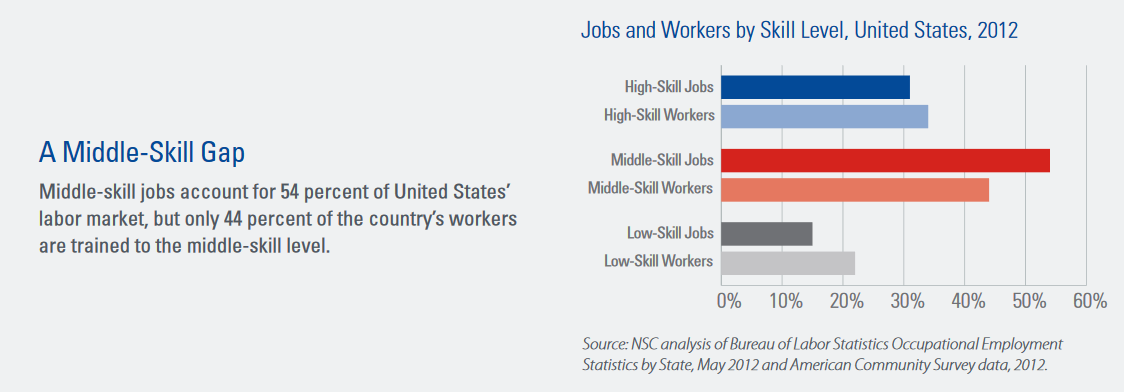Millions of Good U.S. Jobs Exist — but Americans Can't Fill Them
By:
President Donald Trump campaigned on a platform of "bringing jobs back" to the U.S. and described the current economy as a wasteland of closed factories, shuttered plants, and urban blight.
But the reality is that there are 5.5 million unfilled U.S. jobs, the Labor Department reported.
And most of the unfilled jobs aren't low-wage "McJobs" or part-time gigs: They are well-paying, middle class jobs, and employers are struggling to find qualified people to fill them.
Why? There's a mismatch between employers with jobs and employees who need them.
This is the problem — and opportunity — presented by so-called middle-skill jobs.
Middle-skill jobs are full-time careers that require some post-high school education — such as certification, licensing, or vocational school — but not a four-year college degree.
These include jobs in medicine and health care, programming and information technology, skilled manufacturing, specialized sales, database management, and construction.
"Historically, middle-skill jobs served as the springboard to the middle class," according to a Harvard Business School study aptly titled "Bridge the Gap: Rebuilding America's Middle Skills."
"Their productivity drove America’s competitiveness," the study said. "Over the past three decades, however, the United States steadily lost its capability to create and sustain enough jobs to support the realization of the American dream for millions of workers."
Market forces have eroded the number of middle-skill jobs available, while the drive by high schools to send every student to college while neglecting vocational programs has left a deficit of new workers to fill positions in those fields that are expanding.
 National Skills Coalition - nationalskillscoalition.org
National Skills Coalition - nationalskillscoalition.org
Middle-skill jobs are the biggest part of the American labor market, accounting for more than 54 percent of all jobs in 2012, according to the National Skills Coalition. The group projected that demand for such jobs will remain steady well into the 2020s.
Yet millions of these jobs go unfilled, while the unemployment rates of both high school and college graduates remain stagnant.
As a result, part-time employment has greatly increased, while the long-term unemployed have struggled to re-enter the work force, the Harvard Business School study found.
Recent college graduates have been hit especially hard.
About 45 percent of recent college graduates are underemployed, with younger graduates making up 40 percent of the unemployed population — while holding an average of $30,000 in student debt, according to JP Morgan Chase.
"There are millions of jobs going begging right now in what has got to be one of the biggest mismatches between skills and lack of qualified help available in the nation's history," Chris Rupkey, chief economist at MUFG Union Bank, told Reuters last year.
Bridging this gap will require considerable effort on the part of employers, educators, and policy makers, according to labor experts and economists.
But it can be done.
The Harvard Business School study laid out a number of suggestions:
- Companies should make long-term investments in technical schools, while cultivating talent through internships and on-the-job training and reducing unneeded requirements for a bachelor's degree.
- Educators should forge relationships with major local employers, provide accurate information on job skills, take the stigma off community college and vocational training, and focus on long-term careers rather than short term gigs.
- Lawmakers should foster small-business job creation and give incentives for schools and community colleges to expand their vocational training and certificate programs.
Taking these and other steps to foster connections between employers and prospective employees will serve the needs of both.
It will reduce the ever-widening gap between available jobs and the skills they require. And it won't rely on fantastical promises to "bring the jobs back."
